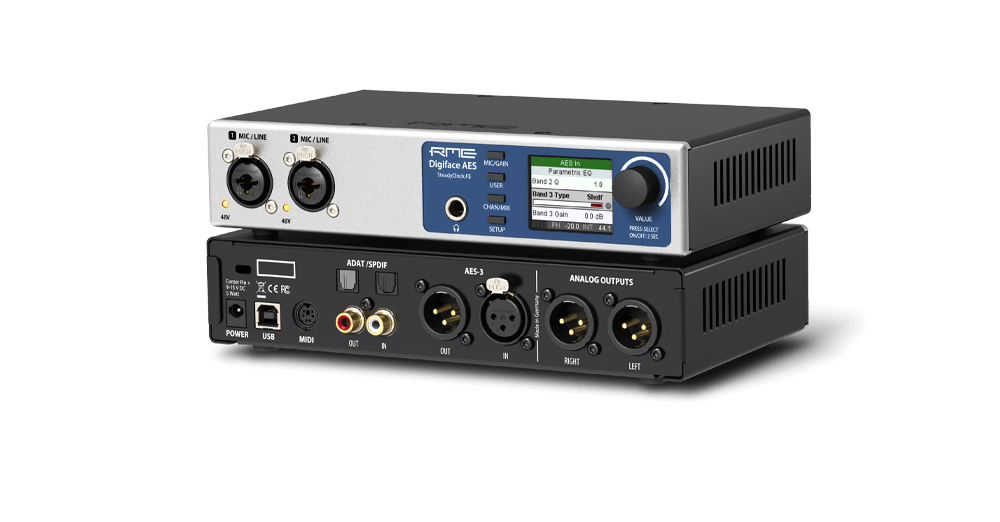This is a review and detailed measurements of the RME Babyface Pro
FS Portable professional audio interface (ADC, DAC, headphone and digital I/O). It was kindly sent to me by the company. The Babyface Pro FS Costs US $899. It is an upgrade to the non-FS version of the same product.
The Babyface Pro FS makes a hugely positive impression the minute you take it out of its nice hard case:
Machined out of a solid chunk of aluminum, it is quite heavy and sits still even with heavy XLR cables pulling on it.
The LED displays are bright and cheery and hard buttons are easy to figure out (I did not even bother with the manual).
The side panel has provision for external power but it is not needed. Despite all of its functionality and LED bar graph, the Babyface Pro FS is entirely "bus powered" via USB 2.0:
The only reason to use an external power supply is for stand-alone operation or with a tablet. The DC connector is the great locking one that is used in higher-end ADI-2 Pro range of products.
Here is the other side showing two analog inputs and headphone out:
Love the rear mount XLR ports so the cables can nicely go back to the end of the desk:
For this review, I only used the XLR connections above and the headphone out. The input connectors are for microphone and hence high gain. I dialed down the gain using the rotary control and ran with it.
I was very pleased that the ASIO driver package was just 10 kBytes (yes, kilobytes) with no bloatware. Reliability was rock solid which is more than I can say for some other interfaces.
DAC Audio Measurements
Let's start testing each subsystem independently starting with USB In and XLR Out as if we just have a simple DAC:
View attachment 56591
I adjusted the output to 4 volts. I was pleasantly surprised that despite being USB powered, the unit could push out over 6 volts at max volume!
At this voltage, measured SINAD of 107 dB is much better than specified 102 dB. No, this is not state-of-the-art performance. For that you need to go to higher up the line units. There is a ton of functionality here in a portable unit so performance is somewhat relaxed:
View attachment 56593
Signal to noise ratio falls in the same targeted place:
View attachment 56594
"FS" stands for high-performance clocking in RME parlance and we see that reflected in the jitter test:
View attachment 56595
Nothing rises above the noise floor represented at -150 dB here.
Linearity is perfect in one channel but a bit off in the other:
View attachment 56596
IMD performance is good:
View attachment 56597
32-tone signal at 192 kHz sampling shows similar results:
View attachment 56598
THD+N versus frequency measured with 90 kHz wide bandwidth shows nice, organized response indicating no out of band garbage:
View attachment 56599
Analog to Digital Converter (ADC) Performance Measurement
Starting with our dashboard we get:
View attachment 56600
Nearly identical peformance as the DAC, placing the unit above average in our list of interfaces tested so far:
View attachment 56601
Frequency response is more than wide enough for what you want to capture for high-resolution music:
View attachment 56602
The Babyface Pro FS easily leaves high-end consumer cards on noise and distortion:
View attachment 56603
Feeding the ADC the same J-test signal we use for DACs allows us to see intrinsic jitter performance:
View attachment 56605
The blue is my non-FS version of ADI-2 Pro which has some low frequency jitter. Babyface Pro FS has none of that.
Headphone Amplifier Audio Measurements
Let's start with the all important power versus distortion and noise into 300 ohm load:
View attachment 56606
I like to see 100 milliwatts here so that any headphone can be driven and we are not there. But what is there is very low noise and distortion.
Performance with a much lower load impedance of 33 ohm is not as good though:
View attachment 56607
There is not a lot of power there and the reason is high output impedance:
View attachment 56608
So the output is really for high impedance headphones that are not impossible to drive.
EDIT: specs show that the 3.5mm jack has near zero output impedance so above is not an issue in practice.
Conclusions
RME sets the performance bar at "very competent" and easily meets that with Babyface Pro FS. Yes, it would be great to have state-of-the-art performance but what is there is sufficient for its target application. The headphone output is good for casual monitoring but doesn't have the horsepower to drive difficult or low impedance headphones.
The hardware/mechanical packaging is a delight as it the ability to use it without an external power supply.
There is a ton of functionality here that I have not included in my testing. Nor other important factors such as low-latency capture and monitoring. So there is a lot more here than a simple desktop DAC/ADC.
Overall,
I am happy to recommend the RME Babyface Pro FS.
------------
As always, questions, comments, recommendations, etc. are welcome.
Waited a week to mail people's boxes so today was a ship day. No less than six, mostly heavy packages had to be wrapped up, labeled and driven to the drop off location. Got stuck behind someone at the post office mailing 18 (!) little envelops wrapped in fancy wrapper to her grandchildren! In summary, I have less money in the bank and got exposed to a germ or two. If this made you feel sorry for me, please
donate what you can using
: https://www.audiosciencereview.com/forum/index.php?threads/how-to-support-audio-science-review.8150/

